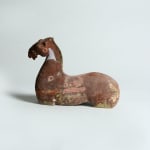Han Polychrome Torso of a Horse, 206 BCE - 220 CE
Terracotta
33 x 40.6 cm
13 x 16 in
13 x 16 in
H.017
Further images
This pottery figurine is sculpted to show the strong, bol line and muscularity of the horse. Onc part of an assembled set, this horse bears the characteristics associated wit the...
This pottery figurine is sculpted to show the strong, bol line and muscularity of the horse. Onc part of an assembled set, this horse bears the characteristics associated wit the famed Heavenly Horse of Fergana. It long muscular neck, arched mane, stylistically curved snout, flared nostrils an gaping mouth depict a horse of regal origin. The figurine is painted in red pigment with designs representing saddl and bridle painted on. White and pink swirled sashes and ribbons are drawn onto th body, complimenting the animal's own natural beauty and grace.
Valued for its speed, strength and beauty, the hors has been one of the most admired animals in China. The horse has enabled man t swiftly transport massive armies into distant and neighboring territories i order to secure vast wealth and land. According to lore, there existed a hors so powerful and beautiful that it was believed to be bequeathed from heaven. I early China, owning a horse required wealth and status, eventually becoming as sign of one's social standing. Equestria activities only encourage the indulgence of the wealthy few who owned horses. Naturally in Chinese art, the horse became a favorite subject of artist who try to create visual representations of the animal that capture both it vitality and presence. During th Han Dynasty, the horse was rendered in miniature sculptural form to be interre with the dead. It was believed tha the animal could assume its powers and assist the deceased in the dangerou journey to the other world. This custom answered to the needs of a particula belief system regarding life after death and the spiritual world.
Valued for its speed, strength and beauty, the hors has been one of the most admired animals in China. The horse has enabled man t swiftly transport massive armies into distant and neighboring territories i order to secure vast wealth and land. According to lore, there existed a hors so powerful and beautiful that it was believed to be bequeathed from heaven. I early China, owning a horse required wealth and status, eventually becoming as sign of one's social standing. Equestria activities only encourage the indulgence of the wealthy few who owned horses. Naturally in Chinese art, the horse became a favorite subject of artist who try to create visual representations of the animal that capture both it vitality and presence. During th Han Dynasty, the horse was rendered in miniature sculptural form to be interre with the dead. It was believed tha the animal could assume its powers and assist the deceased in the dangerou journey to the other world. This custom answered to the needs of a particula belief system regarding life after death and the spiritual world.







